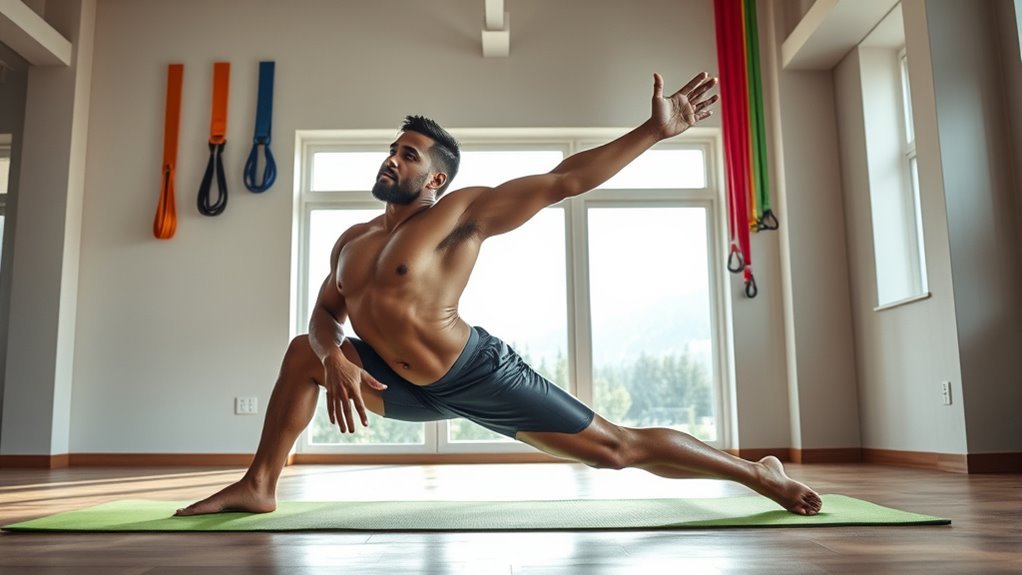Weighted vests can greatly boost your endurance performance by adding resistance that challenges both your muscles and cardiovascular system during workouts. By forcing your body to work harder, these vests enhance your strength, stamina, and aerobic capacity. You'll notice improved heart and lung efficiency, which leads to quicker recovery times. However, it's important to use them properly to avoid potential risks. There's much more to explore on how you can effectively integrate weighted vests into your training.
Understanding Weighted Vests: The Basics
Weighted vests are a versatile training tool designed to enhance your workout by adding extra resistance. You can wear one during various activities like running, hiking, or bodyweight exercises, making it a great option for anyone looking to boost their endurance. By distributing weight evenly across your torso, these vests can help improve your strength and stamina without compromising your freedom of movement.
When choosing a weighted vest, consider its weight and fit. You want something that feels comfortable and secure, allowing you to focus on your workout rather than adjusting your gear. Start with a lighter weight and gradually increase as your strength builds. Incorporating a weighted vest into your routine can elevate your workout experience, helping you achieve that sense of freedom while pushing your limits. Embrace the challenge, and let the extra resistance take your training to new heights! Additionally, using weighted vests can also enhance your cardiovascular endurance, which is crucial for overall performance.
The Science of Resistance Training
While you might think of resistance training as simply lifting weights, it encompasses a variety of methods that can enhance your overall performance, including the use of weighted vests. This type of training focuses on applying external resistance to your body, which can lead to muscle growth, improved strength, and enhanced endurance.
When you increase resistance, your muscles adapt by becoming stronger, allowing you to perform better in various activities. Whether you're running, cycling, or engaging in high-intensity workouts, adding resistance can elevate your training. Incorporating exercises like squats and deadlifts within your routine can further enhance strength and stability, contributing to overall performance improvements.
Using a weighted vest, for example, not only challenges your muscles but also improves your cardiovascular fitness. It encourages your body to work harder, pushing your limits and igniting your freedom to explore new performance heights. Embracing resistance training opens doors to new possibilities, helping you achieve goals you might not have thought possible.
Benefits of Using Weighted Vests for Endurance
Incorporating a weighted vest into your endurance training can greatly enhance your performance. Adding extra weight forces your muscles to work harder, building strength and stamina. You'll find that your body adapts, making everyday activities feel easier and more natural. With a weighted vest, you can push your limits without the constraints of traditional training methods.
Using a weighted vest also helps improve your proprioception, giving you a better sense of body awareness as you move. This can translate to more efficient running or cycling, as you'll develop a stronger connection to your movements. Plus, it adds variety to your workouts, breaking the monotony and keeping your training fresh.
Ultimately, embracing the challenge of a weighted vest can lead to greater endurance, allowing you to explore your potential and enjoy the freedom of movement, whether you're hitting the trails or enjoying a casual jog in your neighborhood. Furthermore, consistent mileage builds aerobic capacity, which can be further enhanced by using a weighted vest during your training sessions.
How Weighted Vests Affect Cardiovascular Performance
When you add a weighted vest to your training routine, you may notice significant changes in your cardiovascular performance. By increasing the load you carry, your heart and lungs have to work harder to deliver oxygen to your muscles. This added challenge can enhance your overall endurance and efficiency. You might find that even simple activities, like jogging or brisk walking, feel different as your body adapts to the extra weight.
As your cardiovascular system becomes more efficient, you could experience improvements in stamina and recovery times. You'll likely notice that your heart rate elevates more during workouts, pushing your limits and helping you achieve greater fitness goals. This added resistance isn't just a burden; it's a pathway to freedom in your physical capabilities. Embracing the weighted vest can transform mundane cardio sessions into powerful, liberating experiences that redefine your endurance potential.
Impact on Muscle Strength and Endurance
When you wear a weighted vest, you might notice enhanced muscle activation during your workouts. This added resistance can boost your aerobic capacity and improve your endurance. Plus, it can help you build fatigue resistance, allowing you to train harder for longer. Additionally, incorporating weighted vests into your routine can promote muscle resilience and enhance recovery times, contributing to overall performance improvements.
Enhanced Muscle Activation
While many athletes seek to improve their performance through various training methods, adding a weighted vest can greatly enhance muscle activation. When you wear a weighted vest, your body works harder, engaging more muscle fibers. This increased activation not only boosts strength but also builds endurance, allowing you to push your limits.
Here's a quick breakdown of how weighted vests impact muscle activation:
| Muscle Group | Activation Level | Benefits |
|---|---|---|
| Chest | High | Improved upper body strength |
| Legs | Very High | Enhanced lower body endurance |
| Core | Moderate | Increased stability and balance |
Incorporating a weighted vest into your routine can lead to noticeable gains, giving you the freedom to excel in your athletic pursuits.
Improved Aerobic Capacity
As you incorporate a weighted vest into your training, you'll likely notice an improvement in your aerobic capacity, which directly impacts both muscle strength and endurance. Adding that extra weight pushes your body to work harder, enhancing cardiovascular efficiency. You'll find that your heart and lungs adapt, allowing you to sustain higher intensity workouts for longer periods. With improved oxygen delivery to your muscles, you'll experience better performance during aerobic activities, from running to cycling. As your endurance increases, so does your ability to push your limits, gaining that sense of freedom in your workouts. Embracing this challenge with a weighted vest could be the key to releasing your full potential, making you stronger and more resilient in your fitness journey.
Fatigue Resistance Benefits
Building on improved aerobic capacity, incorporating a weighted vest also greatly enhances fatigue resistance, which is essential for both muscle strength and endurance. When you wear a vest during workouts, your muscles adapt to the added weight, boosting their ability to sustain prolonged activity. This increase in resistance not only builds strength but also trains your body to push through fatigue more effectively. You'll find that your stamina improves, letting you tackle longer workouts or more intense sessions without hitting that dreaded wall. As you embrace this challenge, you're not just lifting weights; you're liberating your potential. So, strap on that vest, and experience the freedom that comes with enhanced endurance and strength, empowering you to reach new heights in your fitness journey.
Incorporating Weighted Vests Into Training Regimens
Incorporating weighted vests into your training regimen can elevate your workouts and enhance endurance performance. Start by selecting a vest that fits comfortably and allows for a full range of motion. You might want to begin with a lighter weight to gauge how your body responds.
Try adding the vest during your usual cardio sessions—running, cycling, or even brisk walking. You'll feel the added resistance, which can push your limits and boost your stamina over time.
Consider interval training; alternating between high-intensity bursts and recovery periods while wearing the vest can maximize endurance benefits. Also, don't hesitate to integrate it into strength training exercises, like squats or lunges, to further challenge your muscles.
As you adapt, gradually increase the weight to keep your body engaged and avoid plateaus. Embrace this opportunity to elevate your fitness journey and reveal new levels of endurance!
Potential Risks and Drawbacks
While weighted vests can enhance your training, they also come with potential risks. You might face an increased injury risk due to altered biomechanics and weight distribution concerns. It's important to weigh these drawbacks against the benefits before incorporating them into your routine. Additionally, proper warm-ups are crucial to help prepare your muscles and reduce the chances of injury when using weighted vests.
Increased Injury Risk
Although weighted vests can enhance endurance training, they also come with an increased risk of injury. When you add extra weight to your body, it places additional strain on your joints and muscles, making them more susceptible to overuse injuries. You might find yourself pushing harder, but this can lead to imbalances and strains that could sideline you. It's easy to get carried away and forget about proper form, which is essential for avoiding injuries. If you decide to incorporate a weighted vest, listen to your body and stay aware of how it feels during workouts. Prioritize gradual weight increases and adequate recovery to minimize risks, allowing you to enjoy the freedom of movement without unnecessary setbacks.
Altered Biomechanics
When you wear a weighted vest, the added load can greatly alter your biomechanics, leading to potential risks and drawbacks. You might notice changes in your gait, posture, and overall movement patterns. These alterations can increase strain on your joints and muscles, potentially resulting in discomfort or injury over time.
Here's a quick overview of how weighted vests can impact your biomechanics:
| Change in Biomechanics | Potential Risk | Suggested Action |
|---|---|---|
| Altered gait | Increased joint stress | Monitor your stride |
| Forward lean posture | Back strain | Adjust vest fit |
| Uneven weight distribution | Muscle imbalance | Use lighter weights |
| Decreased balance | Fall risk | Practice stability drills |
| Shortened stride length | Reduced speed | Gradually increase load |
Be aware of these factors to maintain your freedom in movement!
Weight Distribution Concerns
Altered biomechanics from wearing a weighted vest can lead to significant weight distribution concerns. When the weight isn't evenly distributed, it can affect your center of gravity, throwing off your balance and making you feel less stable. This imbalance might cause unnecessary strain on your joints and muscles, increasing the risk of injury. You want to enjoy your runs or workouts, but if the vest shifts or feels uncomfortable, it can limit your freedom of movement. It's crucial to verify the vest fits properly and the weight is evenly spread. By being mindful of these factors, you can continue to push your limits without sacrificing your safety or performance. Choose wisely and experience the benefits while minimizing potential drawbacks.
Comparing Weighted Vest Training to Traditional Methods
While many athletes have relied on traditional training methods for endurance performance, incorporating weighted vest training offers a fresh perspective on enhancing physical capabilities. This method not only challenges your body in new ways but can also yield impressive results. Here are a few reasons to take into account weighted vest training over traditional methods:
Many athletes are discovering the benefits of weighted vest training, which offers a unique approach to enhancing endurance and physical capabilities.
- Increased Resistance: Adding weight mimics the demands of competition, pushing your limits further than bodyweight alone.
- Versatility: You can wear a vest during various activities, from running to strength training, making it a flexible tool in your regimen.
- Enhanced Stability: The added weight can help improve core strength and balance, which are vital for endurance sports.
- Progressive Overload: It allows for gradual weight increases, ensuring continuous adaptation and growth. Additionally, building stamina through varied training methods, including weighted vests, can significantly improve overall performance.
Incorporating weighted vests can open new doors to your training, giving you the freedom to explore your full potential.
Success Stories: Athletes Who Swear by Weighted Vests
Many elite athletes have found that incorporating weighted vests into their training regimens has greatly boosted their performance. Take a moment to reflect on the stories of runners and triathletes who swear by this game-changing gear. They've discovered how adding extra weight can challenge their bodies, pushing them to new limits while building strength and endurance.
For instance, a marathon runner shared how wearing a vest during long runs transformed her stamina, allowing her to tackle race day with newfound confidence. Similarly, a professional cyclist credits his weighted vest workouts for improving his speed and power on the bike.
These athletes embrace the freedom that comes from breaking barriers and achieving personal bests. By adopting weighted vests, they've not only enhanced their physical capabilities but also redefined what's possible in their sports. This approach aligns with the fact that muscle efficiency improves with endurance training, enabling athletes to push their limits even further. You could be next, experiencing the thrill of enhanced performance with just a simple addition to your training.
Future Trends in Endurance Training With Weighted Vests
As the demand for innovative training methods grows, weighted vests are poised to become a staple in endurance training programs. They offer you the freedom to customize workouts, push your limits, and enhance performance. Here are some future trends you might want to take into account:
- Technology Integration: Expect vests equipped with sensors that monitor heart rate, calorie burn, and even posture, providing real-time feedback.
- Personalization: Training programs will likely become more tailored, allowing you to adjust the weight and intensity based on your goals and fitness level.
- Hybrid Training: Combining weighted vest workouts with other methods, like cycling or swimming, will create more versatile training regimens.
- Community Engagement: Group training sessions utilizing weighted vests can foster camaraderie and motivation, making workouts more enjoyable.
Additionally, proper hydration plays a crucial role in maximizing the benefits of weighted vest training, ensuring you maintain energy levels and performance during workouts.
Embracing these trends can elevate your endurance training, giving you the edge you need to excel.
Frequently Asked Questions
Can Beginners Safely Use Weighted Vests During Training?
You might think beginners can't safely use weighted vests, but with proper guidance and gradual progression, they can. Embrace the journey, feel empowered, and explore your limits while prioritizing safety and listening to your body.
How Do I Choose the Right Weight for My Vest?
To choose the right weight for your vest, start light—about 5-10% of your body weight. As you progress, you can gradually increase it, ensuring you maintain form and comfort throughout your workouts.
Are There Age Restrictions for Using Weighted Vests?
There aren't strict age restrictions for weighted vests, but studies show younger individuals can benefit from light weights. Just make certain you're mindful of your body's limits, keeping your workouts enjoyable and safe. Freedom in fitness is key!
Should I Wear a Weighted Vest for All Types of Workouts?
You shouldn't wear a weighted vest for every workout. It can enhance strength training, but for cardio or flexibility-focused sessions, it might hinder your performance. Listen to your body and adjust accordingly for peak results.
How Do Weighted Vests Affect Running Form and Technique?
Wearing a weighted vest might feel like sprinting with a boulder on your back! It can alter your running form, potentially leading to poor technique, so be cautious and focus on maintaining proper posture and stride.




